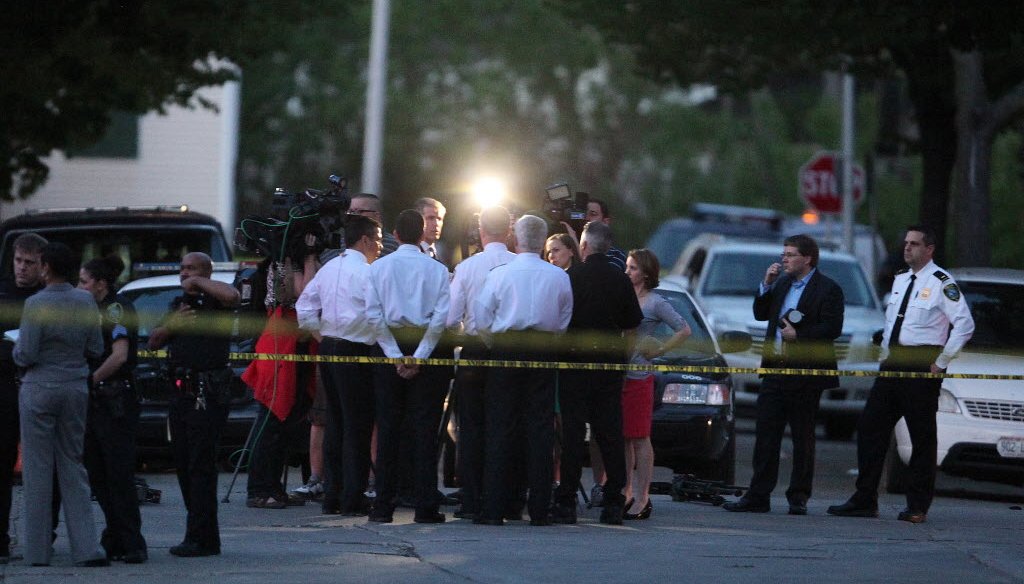



Reporters question Milwaukee Police Chief Edward Flynn about 10-year-old Sierra Guyton, who was shot while playing on a playground on May 21, 2014. Wounded in a crossfire between two men, the girl later died.
The state’s largest police union explained its endorsement of Mary Burke for governor by saying Wisconsin has become more dangerous.
"Under Scott Walker, not only has Wisconsin trailed its neighbors in creating jobs but in combating violent crime as well," Jim Palmer, the Wisconsin Professional Police Association's executive director, told reporters on Sept. 25, 2014.
"The crime data shows that Wisconsin has become less safe than it was when Scott Walker took office."
Unlike many statistics-driven claims we have seen, the union did not offer a specific number for a narrow period. Rather, it cited the more general "less safe" and pointed to the nearly four years since Walker took office.
It also added an element of blame -- that any increase in violent crime is at least partly Walker’s fault.
Many factors -- demographics, rates of incarceration, even police misreporting offenses -- can contribute to fluctuations in the incidence of crime, which is typically viewed more as a local issue than a statewide one.
Still, the governor does have some say in how much money local governments have to spend.
So let’s investigate.
Violent crime data
Palmer referred us to the FBI’s Uniform Crime Reports. Four offenses are counted as violent crimes: murder and nonnegligent manslaughter, forcible rape, robbery and aggravated assault.
One problem: The most recent year available is 2012, so the numbers only cover about half of Walker's time as governor.
We found that Wisconsin’s violent crime rate declined each year from 2007 through 2011, Walker’s first year in office, but increased in 2012.
Year
Wisconsin population
Number of violent crimes
Violent crimes/ 100,000 people
One-year change in rate
5,711,76
13,532
236.9
-4.7%
5,726,398
16,064
280.5
+18.4%
Nationally, violent crime also declined each year 2007 through 2011.
But, in contrast to Wisconsin, the national rate declined again in 2012, to 386.9 violent crimes per 100,000 residents.
In any case, it’s important to note that based on available statistics, the union's claim can't account for nearly the entire second half of Walker’s term. That is a significant unknown.
Walker’s role
As for pinning an increase in Wisconsin’s violent crime rate on Walker, local police and sheriff’s departments -- not the State Patrol or Capitol Police -- are most responsible for fighting crime.
At the same time, cities, villages, towns and counties get a big chunk of their revenue from the state. And Walker also put strict limits on how much local governments could raise property taxes.
Palmer pointed us to Walker’s first state budget, for 2011-’13 -- which reduced "shared revenue" to local governments. He also cited a related fact-check we did during the failed campaign to recall Walker in 2012.
In that item, we found that Walker cut shared revenue by $76 million, or 9 percent -- the largest reduction in at least a decade.
But two other points from that fact-check are also important:
Shared revenue is general aid from the state that local governments use for various programs, not just police and fire. The state money is typically mixed with local money and isn’t tied to a specific local government function.
Walker’s Act 10 collective bargaining reform law helped many local governments absorb at least some of the shared revenue cuts by forcing most public employees (though not police and firefighters) to pay more for their health and pension benefits.
As for the size of law enforcement agencies, Palmer cited state Office of Justice Assistance statistics covering the more than 12,000 sworn officers in local police and sheriff’s departments, as well in the State Patrol, universities and the state Department of Natural Resources. The number of sworn officers per 1,000 residents declined by 2 percent in 2011 and 1.8 percent in 2012.
But local governments, not the governor, ultimately make decisions that determine the lion’s share of front-line law enforcement officers around the state.
Our rating
The Wisconsin Professional Police Association union said: Data on violent crime shows Wisconsin "has become less safe than it was when Scott Walker took office."
In 2012, Walker’s second year in office, violent crime increased and he reduced funding to local governments.
But the available violent crime data cover only about half of Walker’s time in office, so the union’s statement is based at best on a partial picture. Beyond that, a number of factors other than the governor bear on the rate of violent crime.
For a statement that contains an element of truth but ignores critical facts that would give a different impression, our rating is Mostly False.
Milwaukee Journal Sentinel, "Mary Burke stumbles when asked to define plagiarism," Sept. 25, 2014
Wisconsin Professional Police Association, news release, Sept. 25, 2014
PolitiFact Wisconsin, "Tom Barrett says Gov. Scott Walker’s budget made ‘draconian’ public safety cuts," June 3, 2012
Interview and email interview, Wisconsin Professional Police Association executive director Jim Palmer, Sept. 25, 2014
FBI, Uniform Crime Reports for Wisconsin, 2008, 2009, 2010, 2011, 2012
FBI, "Crime in the United States -- 2012"
Wisconsin Office of Justice Assistance, "Crime in Wisconsin 2012," September 2013
Wisconsin Department of Revenue, "County and Municipal Revenues and Expenditures -- 2010," January 2012
Wisconsin Department of Revenue, "County and Municipal Revenues and Expenditures -- 2011," January 2013
Wisconsin Department of Revenue, "County and Municipal Revenues and Expenditures -- 2012," January 2014
Wisconsin Office of Justice Assistance, "Law Enforcement Employees in Wisconsin -- 2010," April 2011
Wisconsin Office of Justice Assistance, "Law Enforcement Employees in Wisconsin -- 2012," Februaryl 2013
In a world of wild talk and fake news, help us stand up for the facts.
